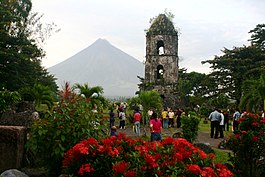Bicol Region

Bicol Region

Bicol Region Region V | |
|---|---|
Region | |
From top, then left to right: Mayon Volcano and Cagsawa Ruins; Legazpi Cathedral; Lake Bulusan; Porta Mariae; Ateneo de Naga University Church; Itbog Falls | |
Nicknames:
| |
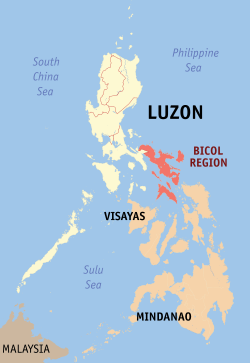 Location in the Philippines | |
| Coordinates:13°30′N 123°20′E [46] | |
| Country | |
| Island group | Luzon |
| Regional center | Legazpi |
| Area | |
| • Total | 18,155.82 km2(7,010.00 sq mi) |
| Population (2015 census)[1] | |
| • Total | 5,796,989 |
| • Density | 320/km2(830/sq mi) |
| Time zone | UTC+8 (PST) |
| ISO 3166 code | PH-05 |
| Provinces | 6
|
| Cities | 7
|
| Municipalities | 107 |
| Barangays | 3,471 |
| Cong. districts | 14 |
| Languages | |
| Website | dilgbicol.org [47] |
The Bicol Region (Central Bicolano: Rehiyon nin Bikol/Kabikolan/Bicolandia; Rinconada Bicol: Rehiyon ka Bikol; Filipino: Kabikulan), also known simply as Bicol and historically known as Ibalong prior to Spanish colonization, is a region of the Philippines, designated as Region V. Bicol comprises six provinces, four on the Bicol Peninsula mainland (the southeastern end of Luzon) – Albay, Camarines Norte, Camarines Sur, and Sorsogon – and the offshore island provinces of Catanduanes and Masbate.[2]
The regional center and largest city is Legazpi City.[3][4] The region is bounded by the Lamon Bay to the north, Philippine Sea to the east, and the Sibuyan Sea and Ragay Gulf to the west. The northernmost provinces, Camarines Norte and Camarines Sur, are bordered to the west by the province of Quezon.
Bicol Region Region V | |
|---|---|
Region | |
From top, then left to right: Mayon Volcano and Cagsawa Ruins; Legazpi Cathedral; Lake Bulusan; Porta Mariae; Ateneo de Naga University Church; Itbog Falls | |
Nicknames:
| |
 Location in the Philippines | |
| Coordinates:13°30′N 123°20′E [46] | |
| Country | |
| Island group | Luzon |
| Regional center | Legazpi |
| Area | |
| • Total | 18,155.82 km2(7,010.00 sq mi) |
| Population (2015 census)[1] | |
| • Total | 5,796,989 |
| • Density | 320/km2(830/sq mi) |
| Time zone | UTC+8 (PST) |
| ISO 3166 code | PH-05 |
| Provinces | 6
|
| Cities | 7
|
| Municipalities | 107 |
| Barangays | 3,471 |
| Cong. districts | 14 |
| Languages | |
| Website | dilgbicol.org [47] |
Geography
The Bicol Region comprises the southern part of Luzon, the largest island in the Philippine archipelago. The total land area is 5.9% of the total land area of the country. Around 69.3% of the total land area is alienable and disposable while the remaining 30.7% is public forest areas.[4]
History
The Bicol region was known as Ibalong, variously interpreted to derive form ibalio, "to bring to the other side"; ibalon, "people from the other side" or "people who are hospitable and give visitors gifts to bring home"; or as a corruption of Gibal-ong, a sitio of Magallanes, Sorsogon where the Spaniards first landed in 1567. The Bicol River was first mentioned in Spanish documents in 1572. The region was also called Los Camarines after the huts found by the Spaniards in Camalig, Albay. No prehistoric animal fossils have been discovered in Bicol and the peopling of the region remains obscure. The Aeta from Camarines Sur to Sorsogon strongly suggest that aborigines lived there long ago, but earliest evidence is of middle to late Neolithic life.[5]
A barangay (village) system was in existence by 1569. Records show no sign of Islamic rule nor any authority surpassing the datu (chieftain). Precolonial leadership was based on strength, courage, and intelligence. The native seemed apolitical. Thus the datu's influence mattered most during crises like wars. Otherwise, early Bicol society remained family centered, and the leader was the head of the family.
The Spanish influence in Bicol resulted mainly from the efforts of Augustinian and Franciscan Spanish missionaries. The first churches in Bicol, the San Francisco Church, and the Naga Cathedral, both in Naga, along with the Holy Cross Parish in Nabua, Camarines Sur, are instituted by the Holy Order of the Franciscans. One of the oldest dioceses in the Philippines, the Archdiocese of Caceres, was also instituted in the Bicol Region. During this time, Bicol was dotted by many astilleros (shipyards) which were focused on constructing Manila Galleons, the heaviest ships in their time, from the local hardwood forests and these Manila Galleons were responsible for trade between Asia and the Americas.[6] Bicol also has Latin-American settlements and cultural influence mostly from Mexico due to the abundance of chili pepper plantations in the area, as it is Mexican in origin.[7] Bicolano cuisine is noted for the propensity of being spicy.[8]
Administrative divisions
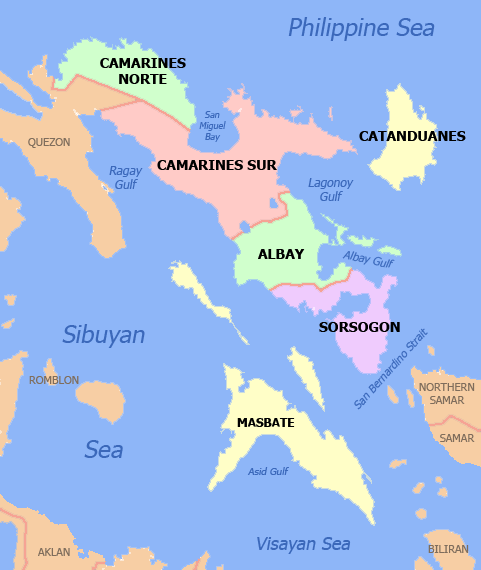
Provinces of Bicol
The region comprises six provinces: Albay, Camarines Norte, Camarines Sur, Sorsogon and the island-provinces of Catanduanes and Masbate.
As of 2015, Camarines Sur is the region's largest province in area and population, occupying 5,481.6 km2 (2,116.5 sq mi) or around 30.4% of the total land area with a population of 1,952,544. Catanduanes is the smallest in area as well as population with only 1,511.5 km2 (583.6 sq mi) or 8.4% of the total regional area and a population of 260,964.[1]
| Province | Capital | Population(2015)[1] | Area[9] | Density | Cities | Muni. | Bgy. | |||
|---|---|---|---|---|---|---|---|---|---|---|
| km2 | sq mi | /km2 | /sq mi | |||||||
| Albay | Legazpi City | 22.7% | 1,314,826 | 2,575.77 | 994.51 | 510 | 1,300 | 3 | 15 | 720 |
| Camarines Norte | Daet | 10.1% | 583,313 | 2,320.07 | 895.78 | 250 | 650 | 0 | 12 | 282 |
| Camarines Sur | Pili | 33.7% | 1,952,544 | 5,497.03 | 2,122.42 | 360 | 930 | 2 | 35 | 1,063 |
| Catanduanes | Virac | 4.5% | 260,964 | 1,492.16 | 576.13 | 170 | 440 | 0 | 11 | 315 |
| Masbate | Masbate City | 15.4% | 892,393 | 4,151.78 | 1,603.01 | 210 | 540 | 1 | 21 | 550 |
| Sorsogon | Sorsogon City | 13.7% | 792,949 | 2,119.01 | 818.15 | 370 | 960 | 1 | 14 | 541 |
| Total | 5,796,989 | 18,155.82 | 7,010.00 | 320 | 830 | 7 | 107 | 3,471 | ||
The region has one independent component city, Naga, and six component cities – Iriga, Legazpi, Ligao, Masbate City, Sorsogon City, and Tabaco. Masbate and Sorsogon are cities in their eponymous provinces.
| City | Population(2015)[1] | Area[10] | Density | City class | Income class | Province | ||
|---|---|---|---|---|---|---|---|---|
| km2 | sq mi | /km2 | /sq mi | |||||
| Iriga City | 111,757 | 137.35 | 53.03 | 810 | 2,100 | Component | 4th | Camarines Sur |
| † Legazpi City | 196,639 | 153.70 | 59.34 | 1,300 | 3,400 | Component | 2nd | Albay |
| Ligao City | 111,399 | 246.75 | 95.27 | 450 | 1,200 | Component | 4th | Albay |
| Masbate City | 95,389 | 188.00 | 72.59 | 510 | 1,300 | Component | 4th | Masbate |
| Naga City | 196,003 | 84.48 | 32.62 | 2,300 | 6,000 | Independent component | 2nd | Camarines Sur |
| Sorsogon City | 168,110 | 276.11 | 106.61 | 610 | 1,600 | Component | 2nd | Sorsogon |
| Tabaco City | 133,868 | 117.14 | 45.23 | 1,100 | 2,800 | Component | 4th | Albay |
Demographics
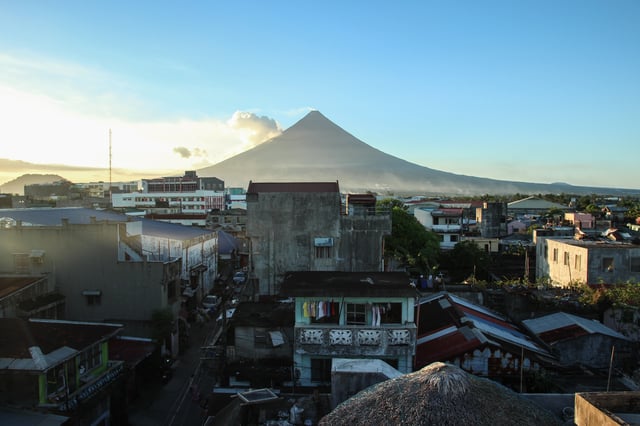
A view of Legazpi City among Mt. Mayon
Bicol Region has a population of 5,796,989 as of 2015 census, growing at an average annual rate of 1.29 percent between 2010 and 2015. The region's population density increased to 320 persons per square kilometer in 2015.
In 1970, Camarines Sur was the only province with close to a million population. Albay, which was next in rank, reached the 1970 population level of Camarines Sur only 20 years later. Masbate and Sorsogon were in the same level every census year from 1970 to 1980. It is noteworthy that distribution and growth of the 1970 population were towards areas that were sparsely populated but agriculturally rich and/or endowed with fishery resources. The island province of Catanduanes and its municipalities have exhibited very low population growth from 1970 to 1980.
In 1980, the pattern was towards urbanization. This was due to the pull of newly installed infrastructures, particularly roads, and the sporadic growth of trade in strategically situated municipalities that have better economic opportunities. The 1990 growth originated from the strong attraction of employment opportunities in established urban centers, which have become a source of growth of adjacent municipalities. This situation was highly evident in Naga and Legazpi areas, whose surrounding municipalities exhibited high growth rates. Unmistakably, the spill-over effects of development permeated those initial high growth areas.
The Bicolanos are descended from the Austronesian-speaking immigrants who came from Southern China during the Iron Age. Many of Bicolanos also have Chinese, Arab, and Spanish admixtures. Most of the townsfolk have Spanish Mixtures and their language is referred to as Bicol or Bicolano. The Bicolano language is very fragmented, and its dialects are mutually incomprehensible to speakers of other Bicolano dialects. The majority of the Bicolano people are devout Roman Catholics due to the Spanish conquering the country and converting them to their religion. Catholic Mass is celebrated daily in many churches in the Bicol Region.
Language
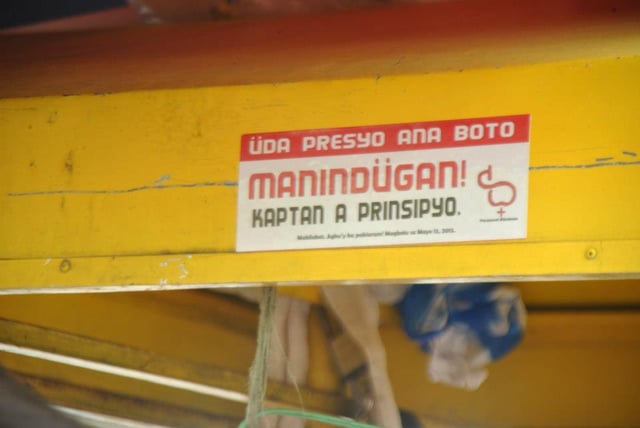
An election campaign sticker written in Rinconada Bikol.
The people of the Bicol Region, called Bicolanos, speak any of the several languages of the Bikol language family, called Bikol macrolanguages, an Austronesian languages closely grouped under the Central Philippine languages family such as the Visayan languages and Tagalog. The four major groups of language in Bikol are Coastal Bikol (with four sub-languages), Inland Bikol (with six sub-languages), Pandan Bikol (lone language) and Bisakol (with three sub-languages). The majority of Bicolanos understand and speak Central Bikol language (a member of Coastal Bikol group of languages) since it is the language used in literature and mass media, but with varying degrees. A known misconception of many Bicolanos is that Central Bikol, used in the cities of Legazpi and Naga, is the standard Bikol. Central Bikol, though spoken by the majority and with speakers represented in all provinces in the region, is not a standard Bikol since other forms of Bikol used in the region are separate languages and usually unintelligible. However, the standard form of Central Bikol language is the Canaman dialect.
Other Bikol languages are Rinconada Bikol, spoken in southern part of Camarines Sur province, Pandan Bikol spoken in northern part of Catanduanes island and the Albay Bikol group of languages that include Buhinon, Libon, West Miraya and East Miraya. Albay Bikol speakers can be found in Buhi, Camarines Sur, central and eastern parts of Albay and in Donsol, Sorsogon. The standard form of Rinconada Bikol both in pronunciation and writing is the Sinabukid (Highland) dialect of Iriga variant. On the other hand, Buhinon of Buhi, Camarines Sur and Libon of Libon, Albay are the languages that are only used in their respective municipalities. Rinconada Bikol and Albay Bikol group of languages are members of Inland Bikol, while Pandan Bikol is the only language with no sub-languages or division.
The majority of the population in Masbate and Sorsogon speaks Masbateño and Sorsoganon respectively. The two are Visayan languages but heavily influenced by Bikol languages (especially the latter), thus tagged and collectively referred to as Bisakol, a portmanteau of Bisaya (Visayan) and Bikol (Bicolano).
Aside from Masbateño, three more Visayan languages are spoken in Masbate, including Hiligaynon/Ilonggo are spoken in the southwestern tip, while Cebuano and Waray-Waray are spoken in the southern part of the island province respectively. Tagalog is the dominant and native language of Bicolanos living in the municipalities in the northern half of Camarines Norte and the town of Del Gallego in Camarines Sur.
Bicolanos also speak and understand Filipino, the national language of the Philippines. English is widely understood in businesses, schools and public places.
Religion
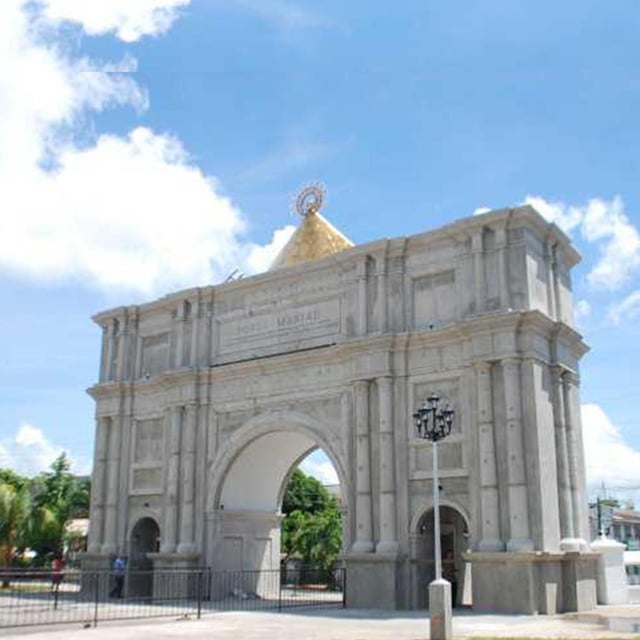
The Porta Mariae in Naga, Camarines Sur
The region retains Roman Catholicism as the overwhelming religion of the great majority. The Catholic religion has the highest number of followers than any other area in the Philippines. The Catholic church grew in the Bicol Region through the efforts of the Bishops from Nueva Caceres (Naga) from the 14th century until the Philippine Revolution in 1898. Naga, Camarines Sur is the religious center of the Bicol Region and is the seat of one of the oldest dioceses in the Philippines, the ecclesiastical Archdiocese of Caceres. Other dioceses include are the Dioceses of Legazpi, Sorsogon, Daet, Masbate, Libmanan and Virac. Fiestas (Feast day of saints) are annual celebrations of parishes, from a simple barrio fiesta honoring a patron associated for good harvest, to a town fiesta honoring a miraculous saint, a diocesan fiesta like the feast of Our Lady of Salvation, or a regional one such as the Our Lady of Peñafrancia Fiesta, the largest Marian devotion in Asia, a week-long celebration to honor the Virgin Mary, dubbed as the "Patroness of Bicolandia". In Luzon, the Bicol Region holds the most number of men entering the seminary for Catholic priesthood, or women entering the religious life to become Catholic nuns. This can be accredited to the Holy Rosary Minor Seminary, Daughters of Mary, and Daughters of Charity Convents in Naga.
The largest minority religion in the region is Iglesia ni Cristo (INC) known for its magnificent worship buildings, commonly called chapels or kapilya, with towering spires that dot the Bicol landscape. Each province represents one ecclesiastical district (E.D.) with the exception of Camarines Sur which is divided into two – Camarines Southwest E.D. in Naga, and Camarines Southeast E.D. in Iriga City. In total, INC has seven ecclesiastical districts in the Bicol region. The chapel of local congregation of Legazpi, Albay is the biggest.
Other religions are also well represented in Bicol such as Jehovah's Witnesses, Protestants denominations of Seventh-Day Adventist church, Baptist Church, Pentecostal, and indigenous religions.
Prior to colonization, the region had a complex religious system which involved various deities. Among these deities include: Gugurang, the supreme god who dwells inside of Mount Mayon where he guards and protects the sacred fire in which Aswang, his brother was trying to steal. Whenever people disobey his orders, wishes and commit numerous sins, he would cause Mount Mayon to burst lava as a sign of warning for people to mend their crooked ways. Ancient Bikolanos had a rite performed for him called Atang.;[12][13] Asuang, the evil god who always try to steal the sacred fire of Mount Mayon from his brother, Gugurang. Addressed sometimes as Aswang, he dwells mainly inside Mount Malinao. As an evil god, he would cause the people to suffer misfortunes and commit sins.[12][13] Enemy of Gugurang and a friend of Bulan the god of the moon; Haliya, the masked goddess of the moonlight and the arch-enemy of Bakunawa and protector of Bulan. Her cult is composed primarily of women. There is also a ritual dance named after her as it is performed to be a counter-measure against Bakunawa.;[14] Bulan, the god of the pale moon, he is depicted as a pubescent boy with uncommon comeliness that made savage beast and the vicious mermaids (Magindara) tame. He has deep affection towards Magindang, but plays with him by running away so that Magindang would never catch him. The reason for this is because he is shy to the man that he loves. If Magindang manages to catch Bulan, Haliya always comes to free him from Magindang's grip; Magindang, the god of the sea and all its creatures. He has deep affection to the lunar god Bulan and pursues him despite never catching him. Due to this, the Bicolanos reasoned that it is to why the waves rise to reach the moon when seen from the distant horizon. Whenever he does catch up to Bulan, Haliya comes to rescue Bulan and free him immediately; Okot, god of forest and hunting; and Bakunawa, a gigantic sea serpent deity who is often considered as the cause of eclipses, the devourer of the sun and the moon, and an adversary of Haliya as Bakunawa's main aim is to swallow Bulan, who Haliya swore to protect for all of eternity.[15]
Culture and traits

Bicol Express
The Bicolano cuisine is primarily noted for the prominent use of chili peppers and gata (coconut milk) in its food. A classic example is the gulay na lada, known outside the region as Bicol Express, a well-loved dish using siling labuyo (native small chillies) and the aforementioned gata.
Like their other neighboring regions, Bicolanas are also expected to lend a hand in household work. They are even anticipated to offer assistance after being married. On the other hand, Bicolano men are expected to assume the role of becoming the primary source of income and financial support of his family.
Bicolanos are also known for being very religious, the place is known for Senora De Penafrancia. Bicolanos are often sweet, regionalistic, friendly, adventurous, puts high importance on education and social status. Contrary to what is believed, not all Bicolanos are fond of chili. Men often know how to cook.
Infrastructure
Roads and Bridges
Matnog - Sta. Magdalena - Bulusan Road - This project was a road improvement of Matnog - Sta. Magdalena - Bulusan Road, linking the coastal barangays of Sta. Magdalena - Bulusan - Matnog in the Province of Sorsogon. This road also serves as an alternate route due to the traffic impairment along Daang Maharlika and also an access road leading to different tourist destination. The project was started in August 06, 2015 and was completed on July 20, 2018.[16]
Economy
Bicol Region has a large amount of rich flatland, and agriculture is the largest component of the economy, followed by commercial fishing. Coconuts, abaca, banana, coffee and jackfruit are the top five permanent crops in the region. Rice and corn are among the chief seasonal crops. Mining is also one of the contributors to the region's economy. Commercial fishing is also important with thirteen major fishing grounds supplying fish markets in places as far as Metro Manila.[17]
Tourism

Whale shark spotting in Donsol, Sorsogon
The region's tourism industry has been revived by the popularity of Mayon Volcano, the new CamSur Water Sports Complex, whale shark spotting, among others, which consequently increased the number of upscale resorts. Naga City has its colonial churches, and pilgrimages to Our Lady of Peñafrancia.[18][19][20]
The municipality of Daet and Catanduanes province have long been destinations for surfers.[21] The opening of the Southern Luzon International Airport in Legazpi City, which is under construction, is hoped to further boost tourism in the region.
Geology
Bicol region is highly volcanic in origin and part of the Pacific Ring of Fire. Known as the Bicol Volcanic Arc or Chain, the volcanoes are the results of the Philippine Sea Plate subducting under the Philippine Mobile Belt, along the Philippine Trench. Volcanism is evident by the number of hot springs, crater lakes, and volcanoes that dot the region starting from Mount Labo in Camarines Norte to the Gate Mountains in Matnog, Sorsogon.[22]
Mayon Volcano is the most prominent of the volcanoes in the region, famous for its perfect conical shape and for being the most active in the Philippines. Its eruptions have repeatedly inflicted disasters on the region, but during lulls in activity, it is a particularly magnificent peak. The southernmost tip of the peninsula is dominated by Bulusan Volcano, the other active volcano in the region. Tiwi in Albay and the Bacon-Manito area between Sorsogon and Albay are the sites of two major geothermal fields that contribute substantially to the Luzon Power Grid.[23][24]
Volcanoes
From North to South
| Pdadawophjaf→→→→→→→→§dadfaiyhdjasfvjad4 | Name |
|---|---|
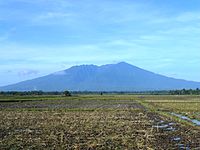 | Mount Isarog is a 1,966-metre (6,450 ft) fumarolic volcano with a 2.5-kilometre (1.6 mi) wide crater breached to the east.[25] The mountain and vicinity covering 10,112 hectares (24,990 acres) is a protected area in the Bicol Region under the name Mount Isarog Natural Park.[26] |
 | Mount Iriga is a 1,196-metre (3,924 ft) volcano with a large horseshoe-shaped collapsed crater located adjacent to Lake Buhi (foreground).[27] |
 | Mount Malinao is a 1,548-metre (5,079 ft) volcano with a large crater about 3 kilometres (1.9 mi) at its widest, which is breached to the asdasf
ad}Dc xpaP:SledAsdiapss;ed'mdas} PRS{Af /
af a
s.dsa]e;as=dpla;s
df;sa-idsak
]0f
east, The geothermal fields of Tiwi are located on its lower eastern slope.[28] |
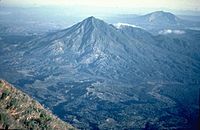 | Mount Masaraga is a sharp-topped 1,328-metre (4,357 ft) Holocene volcano NW of Mayon.[29] |
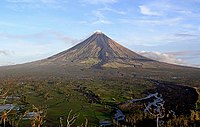 | Mayon Volcano, the highest point of the region at 2,463 metres (8,081 ft), is also the most popular in the region for its beautifully symmetrical cone. It is also the most active in the country.[30] The volcano is one of the protected areas of Region V under the name Mayon Volcano Natural Park encompassing 5,776 hectares (14,270 acres).[26] |
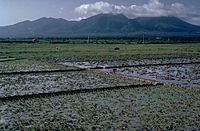 | Pocdol Mountains with its highest elevation at 1,102 metres (3,615 ft), is a fumarolic group of volcanoes situated between Albay and Sorsogon provinces. It is the location of the Bac-Man Geothermal Power Plant and the PNOC Eco-Park, a 25,100-hectare (62,000-acre) ecotourism park maintained and protected by the Philippine National Oil Company (PNOC).[31][32] |
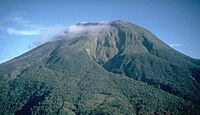 | Bulusan Volcano, the other active volcano of the region, has an altitude of 1,565 metres (5,135 ft). It is located on the remains of the 11-kilometre (6.8 mi) Irosin Caldera.[33] The volcano is a protected area and the centerpiece of the 3,672-hectare (9,070-acre) Bulusan Volcano Natural Park.[26] |
Education
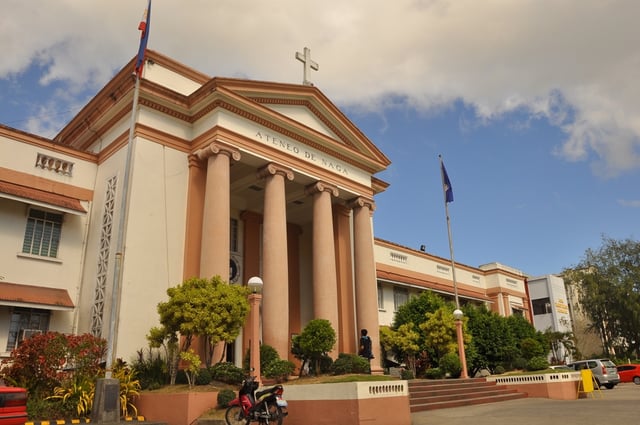
Ateneo de Naga University

University of Nueva Caceres
From 1945 until 2011, the basic education system was composed of six years of elementary education starting at the age of 6, and four years of high school education starting at the age of 12. Further education was provided by technical or vocational schools, or in higher education institutions such as universities. Although the 1987 Constitution stated that elementary education was compulsory, this was never enforced.
In 2011, the country started to transition from its old 10-year basic educational system to a K–12 educational system, as mandated by the Department of Education.[34] The new 12-year system is now compulsory, along with the adoption of new curriculum for all schools (see 2010s and the K–12 program). The transition period will end with the 2017–2018 school year, which is the graduation date for the first group of students who entered the new educational system.
All public schools in the Philippines must start classes on the date mandated by the Department of Education (usually the first Monday for public, second Monday for private and third Monday for some colleges for the month of June) since the presidency of Joseph Estrada in 1999, and must end after each school completes the mandated 200-day school calendar organized by the Department of Education (usually around the third week of March to the second week of April). Private schools are not obliged to abide by a specific date, but must open classes no later than the last week of August.
| Name | Acronym | Province (Main campus) | City/Municipality | President | Established | Population |
|---|---|---|---|---|---|---|
| Bicol State College of Applied Sciences and Technology | BISCAST | Camarines Sur | Naga City | Dr. Richard H. Cordial | 1911 | |
| Bicol University | BU | Albay | Legazpi City | Dr. Arnulfo M. Mascariñas | 1969 | |
| University of Camarines Norte | UCN | Camarines Norte | Daet | Dr. Rusty G. Abanto | 1992 | |
| Catanduanes State University | CSU | Catanduanes | Virac | Dr. Minerva I. Morales, SUC President III | 1961 | |
| Central Bicol State University of Agriculture | CBSUA | Camarines Sur | Pili | Dr. Alberto N. Naperi SUC President IV | 1918 | |
| Dr. Emilio B. Espinosa Sr. Memorial State College of Agriculture and Technology | DEBESMSCAT | Masbate | Mandaon | Dr. Erwin H. Malto | 1952 | |
| Partido State University | PSU | Camarines Sur | Goa | Dr. Raul G. Bradecina | 2001 | |
| Polytechnic State University of Bicol | PSUB | Camarines Sur | Nabua | Dr. Dulce Fajardo-Atian | 1983 | |
| Sorsogon State College | SSC | Sorsogon | Sorsogon City | Dr. Modesto D. Detera | 1907 |
Bicolanos
| Name | Information |
|---|---|
| Leni Robredo | The Vice President of the Republic of the Philippines, politician and lawyer. Served during the 16th Congress as Member of the Philippine House of Representatives from Camarines Sur's Third District.[35] The widow of then Interior Secretary Jesse Robredo. Born in Naga City. |
| Raul Roco | Born in Naga City, a Filipino statesman, prominent lawyer, Congressman, Senator, Secretary of Education) during the Presidency of Gloria Macapagal Arroyo. |
| Francis "Chiz" Escudero | Senator, Vice-presidential aspirant and former Sorsogon representative. |
| Antonio Trillanes IV | Senator, Vice-Presidential aspirant and former military officer, Leader Magdalo group. |
| Gregorio Honasan | Senator, Vice-Presidential aspirant and former military officer. |
| Leila de Lima | Senator, lawyer, human rights activist and politician. She was appointed by president Gloria Macapagal Arroyo as Chairperson of the Philippine Commission on Human Rights in May 2008 and she served in the commission until June 30, 2010, when she was appointed by President Benigno S. Aquino III as the Philippines' Secretary of the Department of Justice. |
| Ceferino "Joker" Arroyo Jr. | Former Senator turned Congressman, statesman and key figure in the 1986 EDSA People Power Revolution which ousted strongman President Ferdinand Marcos. He was Congressman for Makati from 1992 to 2001 and a Senator from 2001 to 2013. Philippine Bar Association’s Most Distinguished Award for Justice as a “man beholden to no one except to his country” and a Senate Resolution No. 100 enacted in the 8th Congress commending him for his invaluable services to the Filipino people. |
| Francisco Tatad | A native from Catanduanes, Former Senator of the Philippines (1992–2001) |
| Jesse Robredo | Secretary of the Interior and Local Government and former Naga City Mayor |
| Irene Cortes | She was a former Associate Justice of the Supreme Court of the Philippines / First Female Dean of the UP College of Law |
| Shalani Soledad-Romulo | Valenzuela representative and TV host |
| Joseph Santiago | Congressman for 2 terms 2004 and 2007. He is a former executive of Pilipino Telephone Corporation. Serves as Commissioner of the National Telecommunications Commission, and From 1997 to 1998, he served as team manager of the Mobiline Cellulars professional basketball team in the Philippine Basketball Association. |
| Leandro Verceles Sr. | Philippine Ambassador, Governor, Philippine Immigration Commissioner, initiator of the Catanduanes Circumferential Road, initiator of the ARDCI, a micro-lending strategy that eventually led to the nationally acclaimed Vision Bank. |
| Leandro Verceles Jr. | Congressman (1992–2001), Governor (2001–2006), Principal author of the Philippine E-Commerce Act that paved the way for the burgeoning $20b BPO industry in the Philippines. |
| Arnulfo Fuentebella | House of Representatives of the Philippines 11th Congress Speaker of the House (2000 -2001) |
| Gina Vera-Perez de Venecia | She is daughter of the famed star-builder of Sampaguita Pictures, then Doc Jose Perez and Azucena Vera-Perez. She is the wife of Jose de Venecia, Jr., Speaker of the House of Representatives of the Philippines from 1992 to 1998 and 2001 to 2008. |
| José María Panganiban | A Filipino propagandist, linguist, and essayist. He is one of the main writers and contributors for La Solidaridad, writing under the pen names "Jomapa" and "J.M.P." |
| Name | Information |
|---|---|
| Merlinda Carullo Bobis | Born in Legazpi City, she is a contemporary Filipino writer and academic in Australia |
| Name | Information |
|---|---|
| Bernabe Concepcion | A native of Catanduanes and Filipino featherweight boxer |
| Don Trollano | A native from Gigmoto. He is a Filipino professional basketball player for the Rain or Shine Elasto Painters of the Philippine Basketball Association (PBA). |
| Reil Cervantes | From Virac. Is a Filipino professional basketball player for Blackwater Elite in the Philippine Basketball Association (PBA). He was drafted 9th by Barangay Ginebra Kings in the 2011 PBA draft.[36] In 2014, he was drafted 2nd overall by Kia Sorento in the 2014 PBA Expansion Draft.[37] |
| Name | Information |
|---|---|
| John Arcilla | Is a multi-awarded Filipino movie actor[38][39] and environmentalist.[40] |
| Nora Aunor | Multi-awarded Filipino actress, singer and producer. She is regarded as the "Superstar in Philippine Entertainment Industry". |
| Janelle Quintana Manahan | Teen actress/Best New Female Artist (19th Aliw Awards) nominee |
| Enchong Dee | Born Ernest Lorenzo Dee, is an actor in Naga City, director and model, and an international competitive swimmer. He came to prominence after starring in Katorse (2009). |
| AJ Dee | Born Angel James Dee III in Naga City, is an actor and an international competitive swimmer. He played the role of Tony Javier in the play A Portrait of an Artist. |
| Robin Padilla | Film/TV Actor and model popularly known as The Bad Boy of Philippine Movies. |
| Eddie Garcia | Popularly known as Manoy is a Filipino film actor and film director. A former member of the Philippine Scouts in Okinawa during World War II. The Philippine Military Academy Marangal () Class of 1974, alongside First Gentleman Mike Arroyo. |
| Wally Bayola | Is a Filipino comedian, singer and actor born and raised in Naga City. He is best known appearing alongside his co-tandem Jose Manalo on the noon-time television variety show Eat Bulaga!. |
| Gary V. | Is a Filipino musician. Also known as "Mr. Pure Energy", Valenciano has released 26 albums, and won the Awit Awards for "Best Male Performer" eleven times. In 1998, he became UNICEF Philippines first National Ambassador. |
| Imelda Papin | Is a Filipino singer and one of the bigger names in the Philippine music industry. Dubbed the "Sentimental Songstress", Imelda Papin is responsible for songs such as "Bakit (Kung liligaya ka sa piling ng iba)" and "Isang Linggong Pag-ibig". |
| Kyla | Melanie Calumpad Alvarez in real name. Kyla is a Filipino R&B singer-songwriter, producer, occasional actress and presenter dubbed as the Philippines' "Queen of R&B". |
| Carmen Camacho | 1960s Philippine Kundiman Diva |
| Noel Cabangon | Is a Filipino folk singer and composer, formerly of the band Buklod. He is known for composing socially-relevant songs such as Kanlungan and Tatsulok. |
| Jericho Rosales | Is a Filipino cinema and television actor, model,singer, and songwriter. |
| Bembol Roco | A Filipino film and television actor. He is famous for his role as Julio Madiaga in Maynila: Sa mga Kuko ng Liwanag. |
| Aga Muhlach | Actor,model, host and former matinée idol of Philippine movies. |
| Beatriz Saw | Actress, TV host and Pinoy Big Brother Season 2 big winner |
| Bugoy Drilon | Singer, actor and Pinoy Dream Academy Season 2 2nd Star Dreamer |
| Name | Information |
|---|---|
| Lara Quigaman | Born in Naga City. Film/TV actress,model,host and Miss International 2005 winner. |
| Venus Raj | Beauty queen, TV personality, model, and actress. She was crowned Binibining Pilipinas-Universe 2010. Fourth runner-up in 2010 Miss Universe pageant. |
| Miriam Quiambao | Is a Filipina television personality, occasional actress and 1st runner up at the Miss Universe 1999 pageant. |
| Bea Rose Santiago | Fords model and Miss International 2013 winner. She was born at Cataingan, Masbate. |
| Yvethe Marie Santiago | Graduated in Bicol University College of Business Economics and Management Binibining Pilipinas Supranational 2014 winner. |
| Christi McGarry | A Filipino-American model and beauty pageant titleholder crowned Miss Intercontinental 2015 First runner Up. |
| Rachel Peters | A Filipino-British model and beauty pageant titleholder who was crowned Miss Universe Philippines 2017 |
| Catriona Gray | A Filipino-Australian model and beauty pageant titleholder who was crowned Miss World Philippines 2016 & Miss Universe Philippines 2018 |
| Name | Information |
|---|---|
| Jose Tomas Sanchez | Born in Naga City. Roman Catholic Prefect Emeritus of the Congregation for the Clergy and Cardinal Priest from the Philippines |
| Mike Velarde | Tele-evangelist, founder and Servant-Leader of El Shaddai DWXI-PPFI |
